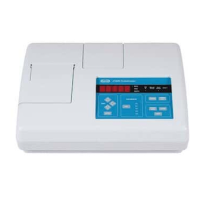SECTION 3, continued
35
3.1.1 Using the RANGE Key
Table 1 on page 34 provides the instrument ranges. Select automatic or
manual ranging by pressing the RANGE key. Repeated presses step the instrument
from automatic range to manual range and then through each of the four manual
range settings.
When automatic ranging is selected, the Auto Range annunciator lights. In manual
ranging, the Manual Range annunciator lights. The instrument automatically
defaults to auto ranging during calibration. Range selection may be made at any
time during sample measurement. If the instrument is turned off, it defaults to the
last selected range setting when power is restored to the instrument.
The display flashes all 9s or all 0s when the sample being measured is over-range
or under-range, respectively, for the manual range selected. The Ratio annunciator
flashes to indicate over-range when Ratio is off.
Press the RANGE key to select the proper higher or lower measurement range. If
the over-range display flashes in Automatic Ranging or in the highest Manual
Range, the sample is over-range for the instrument and must be diluted prior to
measurement (refer to Section 2.8 on page 29).
For samples in excess of 40 NTUs, 268 Nephelos or 9.8 EBCs, the display flashes
9s to indicate over-range if Ratio is off. Ratio must be on to measure samples
above these levels.
3.1.2 Using the UNITS/EXIT Key
This key selects NTU, EBC or Nephelo measurement units. If power is turned off,
the instrument defaults to the last unit selected when power is restored. Press the
UNITS/EXIT key to select units of measure. The unit of measure selected is
indicated by an annunciator next to the instrument display. It can be selected at
any time.
3.1.3 Using the SIGNAL AVG Key
Turn signal averaging on and off by pressing the SIGNAL AVG key. When on, the
last ten measurements are averaged together to minimize the effects of random
spikes in the turbidity measurement (refer to Section 2.7 on page 29).
3.1.4 Using the RATIO key
Turn Ratio on and off by pressing the RATIO key. With RATIO on, all three
detectors (90°, transmitted and forward scatter) are used to make the
measurement. With RATIO off, only the result of measurement with the 90°
detector is displayed. Measurements with Ratio on and measurements with Ratio
off are equivalent for turbidity measurements less than 40 NTU if interferences
due to color or light absorbing particles are not present. However, Ratio on
compensates for instrumental and sample variables. Operation with Ratio on is
recommended for most measurements. Refer to Section 1.3 on page 15 for more
detailed discussion of Ratio on vs. Ratio off measurements.
If the instrument power is turned off, the Ratio selection (on or off) last in use will
be active when power is restored.
Tài liệu sưu tầm của Trung Sơn - www.tschem.com.vn - 028.3811.9991 - info@tschem.com.vn
Tài liệu sưu tầm của Trung Sơn - www.tschem.com.vn - 028.3811.9991 - info@tschem.com.vn

